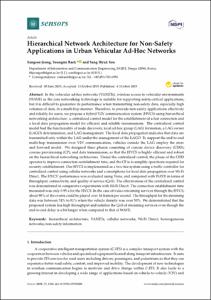Department of Electrical Engineering and Computer Science
Information and Communication Engineering Research Center
1. Journal Articles
Hierarchical Network Architecture for Non-Safety Applications in Urban Vehicular Ad-Hoc Networks
- Title
- Hierarchical Network Architecture for Non-Safety Applications in Urban Vehicular Ad-Hoc Networks
- Author(s)
- Jeong, Sang Soo ; Baek, Youngmi ; Son, Sang Hyuk
- DGIST Authors
- Jeong, Sang Soo ; Baek, Youngmi ; Son, Sang Hyuk
- Issued Date
- 2019-10
- Type
- Article
- Article Type
- Article
- Author Keywords
- hierarchical architecture ; VANETs ; cellular networks ; Wi-Fi Direct ; heterogeneous networks ; non-safety information
- Keywords
- PERFORMANCE
- ISSN
- 1424-8220
- Abstract
- In the vehicular ad-hoc networks (VANETs), wireless access in vehicular environments (WAVE) as the core networking technology is suitable for supporting safety-critical applications, but it is difficult to guarantee its performance when transmitting non-safety data, especially high volumes of data, in a multi-hop manner. Therefore, to provide non-safety applications effectively and reliably for users, we propose a hybrid V2V communication system (HVCS) using hierarchical networking architecture: a centralized control model for the establishment of a fast connection and a local data propagation model for efficient and reliable transmissions. The centralized control model had the functionality of node discovery, local ad-hoc group (LAG) formation, a LAG owner (LAGO) determination, and LAG management. The local data propagation indicates that data are transmitted only within the LAG under the management of the LAGO. To support the end-to-end multi-hop transmission over V2V communication, vehicles outside the LAG employ the store and forward model. We designed three phases consisting of concise device discovery (CDD), concise provisioning (CP), and data transmission, so that the HVCS is highly efficient and robust on the hierarchical networking architecture. Under the centralized control, the phase of the CDD operates to improve connection establishment time, and the CP is to simplify operations required for security establishment. Our HVCS is implemented as a two-tier system using a traffic controller for centralized control using cellular networks and a smartphone for local data propagation over Wi-Fi Direct. The HVCS’ performance was evaluated using Veins, and compared with WAVE in terms of throughput, connectivity, and quality of service (QoS). The effectiveness of the centralized control was demonstrated in comparative experiments with Wi-Fi Direct. The connection establishment time measured was only 0.95 s for the HVCS. In the case of video streaming services through the HVCS, about 98% of the events could be played over 16 frames per second. The throughput for the streaming data was between 74% to 81% when the vehicle density was over 50%. We demonstrated that the proposed system has high throughput and satisfies the QoS of streaming services even though the end-to-end delay is a bit longer when compared to that of WAVE. © 2019 by the authors. Licensee MDPI, Basel, Switzerland.
- Publisher
- Multidisciplinary Digital Publishing Institute (MDPI)
- Related Researcher
-
-
Son, Sang Hyuk
- Research Interests Real-time system; Wireless sensor network; Cyber-physical system; Data and event service; Information security; 실시간 임베디드 시스템
-
- Files in This Item:
-
 기타 데이터 / 3.58 MB / Adobe PDF
download
기타 데이터 / 3.58 MB / Adobe PDF
download



